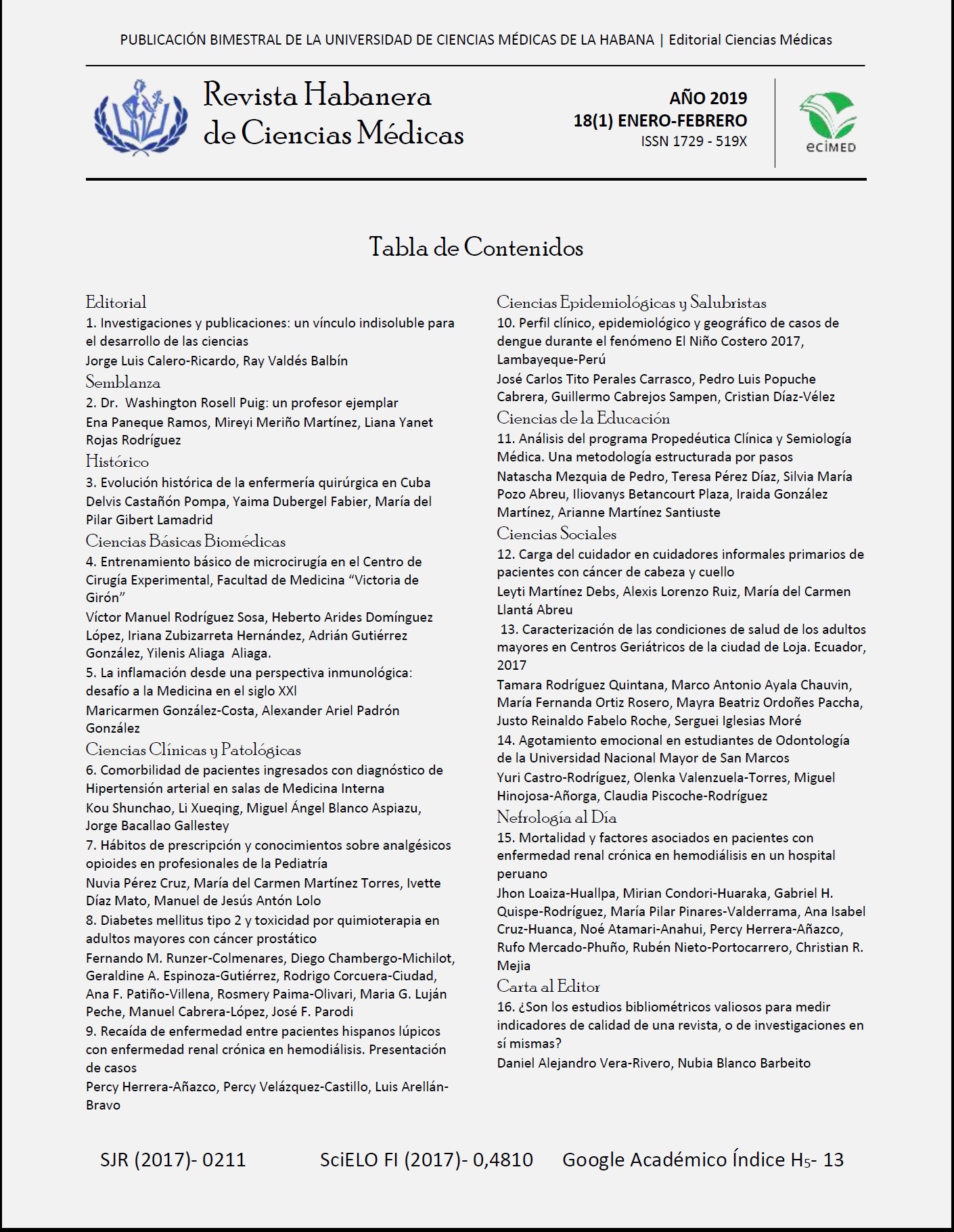Basic microsurgery training. Center for Experimental Surgery, "Victoria de Girón" Institute of Basic and Pre-Clinical Sciences
Keywords:
Microcirugía, entrenamiento microquirúrgico, método de enseñanza microquirúrgico, técnicas microquirúrgicas, microsutura vascular, microsutura nerviosa, microsutura termino-terminalAbstract
Introduction: Microsurgical techniques are currently applied in different surgical specialties worldwide. During the 90´s, our center began to implement vascular and nerve microsurgery trainings to specialists and national and foreign residents, respectively.
Objective: To evaluate the results of microsurgery training that it is taught in the Center for Experimental Surgery at "Victoria de Girón" Institute of Basic and Pre-Clinical Sciences.
Material and methods: A retrospective longitudinal study was carried out to evaluate the microsurgery training program. The training was divided into three main parts: theoretical lessons; practices upon the latex simulator; end-to-end anastomosis of small intestine on the rat; and finally, the development of basic microsurgical techniques on different vascular structures (abdominal aorta and vein) and the sciatic nerve of the rat, for a total of 90 hours of training. The total enrollment during the mentioned period was 203 students to whom a survey was applied at the end of the training; also, the time of realization of anastomosis and the vascular permeability were measured and evaluated as Bad, Good, and Excellent.
Results: The results were satisfactory in general, but 90% of students that were carrying out their studies of a surgical specialty showed better skills in a shorter period than those that didn't practice surgery, demonstrating a less time-consuming exercise in the realization of vessel anastomosis and obtaining a good vascular permeability in this group.
Conclusions: This teaching method constitutes a useful tool so that the students develop the necessary skills to carry out microsurgical practices in clinical surgery successfully.
Keywords: Microsurgery, microsurgical training, microsurgical teaching method, microsurgical techniques, vascular microsuture, nervous microsuture, end-to-end microsutute.
Downloads
References
1. Harri K. Microvascular surgery and its clinical applications: In Plastic and Reconstructive Surgery. 2th ed. Tokyo, Japan: Kokuseido Publishing Co, Ltd; 1977, p. 1-17.
2 .Habal SM. Training in microvascular surgery. Surgery. 1977; 81: 596-598.
3. Yuen Ung Lo C, Tze Yang Tong V, Yuen Hua Loh A, Athanassopoulos T. Microsurgery training––a home do-it-yourself model training—a home do-it-yourself model. Microsurgery .2014; 34: 417-418.
4.Dennis P, Goossens E, Suzann M, Gruel V, Kat R. A survey of microsurgery training in the United States. Microsurgery. 1990; 11:2-4.
5. Chávez-Abraham V, Hadad-Tame JL, Del Vecchyo Calcáneo C, Sastré-Ortiz N. Entrenamiento experimental y clínico en microcirugía para residentes de cirugía Plástica. Cirugía Plástica. 2003; 13 (13): 128-132.
6. Ramírez MA, Contreras D R, Cartes UJ, Martínez MM, Martínez PC, Alvarado SV, Iruretagoyena BM, Martínez CJ. Entrenamiento microquirúrgico básico para realizar un modelo animal de alotrasplante compuesto vascularizado. Rev Chil Cir. 2013; 65(5):389-395.
7. Aymerich Bolaños O. Generalidades de colgajos y su importancia en la relación con la reparación del daño corporal. Med. Legal Costa Rica. 2014; 31(1):49-56.
8. Mikó I, Bráth E, Furka I. Basic teaching in microsurgery. Microsurgery, 2001; 21:121-123.
9. Tamayo Pérez G, Parada Gasson R, Cataño Calatayud R, Juárez Martínez, JL, Espejo S, Rivera R. Enseñanza y desarrollo de habilidades en microcirugía: Modelo pollo. Cirujano General. 2006; 28 (4): 225-9.
10. Molina Martínez JL, Batista Hernández N, Díaz Díaz G, Béquer Mendoza L, Gómez Hernández T, Álvarez Sánchez C, Álvarez Montano AO, Luz Pimentel C. El modelo Pollo como método alternativo y viable en el Laboratorio de Cirugía Experimental. Universidad Médica de Villa Clara. Cuba. REDVET. Rev. Electrón. Vet. [Internet]. España. 2017; [Consultado 5/02/2018]; 18(12):1-16. Disponible en: https://www.redalyc.org/pdf/636/63654640044.pdf
11. Rodríguez Sosa VM, Rodríguez Sosa R, Corona Miranda B. Historia del Centro de Cirugía Experimental del Instituto de Ciencias Básicas y Preclínicas "Victoria de Girón" Rev hab cien méd [Internet]. 2015 [Consultado 19/10/2018]; 14(2):134-147.Disponible en: http://www.revhabanera.sld.cu/index.php/rhab/article/view/855/732.
12. Rodríguez Sosa, VM. Manual de entrenamiento en microcirugía vascular y nerviosa experimental. 4ta edición. La Habana: Cuba: 2018. p. 1-85.
13. Arribalzaga EB, Jacovella PF. Estudio observacional de habilidades quirúrgicas en residentes. Rev Educ Méd.2006; 9(1): 149-152.
14. Andrades CP, Calderón ME, Danilla ES, Erazo CC, Benítez SS, Sepúlveda PS. Microanastomosis venosa mecánica coupler®. Un importante aporte tecnológico a
la microcirugía vascular Rev Chil Cir. 2014; 66(1):52-58.
15. Camacho FJ, Rojas MA. Determinación de los niveles de competencia para entrenamiento básico en microcirugía. Rev Colomb Cir [Internet]. 2016 [Consultado 8/02/2018]; 31: 270-7. Disponible en: https://www.researchgate.net/publication/311593543_Determinacion_de_las_competencias_en_entrenamiento_basico_para_microcirugia.
16. Ramírez MA, Contreras DR, Cartes UJ, Martínez MM, Martínez PC, Alvarado SV, Iruretagoyena BM, Martínez CJ. Entrenamiento microquirúrgico básico para realizar un modelo animal de alotrasplante compuesto vascularizado. Rev Chil Cir. 2013; 65(5): 11-6.
17. Lausada N, Stringa P, Zalazar G, Bustamante J, Escudero E, Raimondi. Trece años de experiencia en la enseñanza teórico-práctica de la microcirugía experimental. Rev Cient Facultad de Ciencias Med. Argentina. 2013; 4(2): 1-1.
18. Matsumura N, HorieTakashi Y, Michiya Kubo S, Hayashi N, Endo S. Basic training model for supermicrosurgery: a novel practice card model. J Reconst Microsurg. 2011; 27(6): 377- 81.



